Business phonographs (and graphophones) were selling poorly in the early years and the phonograph industry was near bankruptcy. But in 1899, someone had the bright idea to built a coin-operated phonograph, record some songs on cylinders, and put the machines into the arcades, which were quite popular at the time. The public loved it. The various companies making phonographs quickly went into the cylinder business, and some of them redesigned their players so that they were cheaper and simpler, hoping that people would buy them for their homes.
The idea of a truly inexpensive machine that could play back (but not record) music was the inspiration for an even more successful technology–the disc record or “gramophone.” Edison himself had considered a disc phonograph, but it was Emile Berliner who really got the ball rolling. Part of the reason for a disc instead of a cylinder was that Berliner thought it would be easy to stamp out large numbers of copies of disc recordings. In 1893 he began selling his cheap gramophone player and seven-inch disc records made of hard rubber. Emile Berliner in 1896 hooked up with Eldridge Johnson, a machinist from Camden, New Jersey who designed an improved gramophone player for the Berliner company. In a short time, the two joined forces to create what would become the Victor Talking Machine Company. Victor in the early 1900s became one of the largest manufacturers of “talking machines” and records. In 1889, Berliner had arranged for the establishment of a branch of his company in London. Although officially known as the Gramophone Company, it was better known by its brand of records, called His Master’s Voice, or HMV, and by Nipper the dog, which later became the mascot for Victor. Meanwhile, the cylinder phonograph business had been in such a shambles that the original owners of the various companies lost control of their businesses to shrewd businessmen.

This painting of a dog listening to a Gramophone became Victor’s advertising trademark after about 1899
The Columbia company had started life leasing business phonographs in Washington, D.C., but was soon making home cylinder graphophones from a factory in Bridgeport, Connecticut. The company’s leader, Edward Easton, was not sure whether cylinders or discs would ultimately succeed, so soon Columbia was manufacturing both. Soon, three companies (Edison, Victor, and Columbia) were the Big Three in the record and record player businesses in the United States, while HMV and the various subsidiaries set up by Edison and Columbia dominated the market in Europe. They were selling about 3 million records a year by 1900 in the U.S. alone. The success of the record industry during the next two decades was phenomenal. Soon, the record industry was one of the most important in the world.

